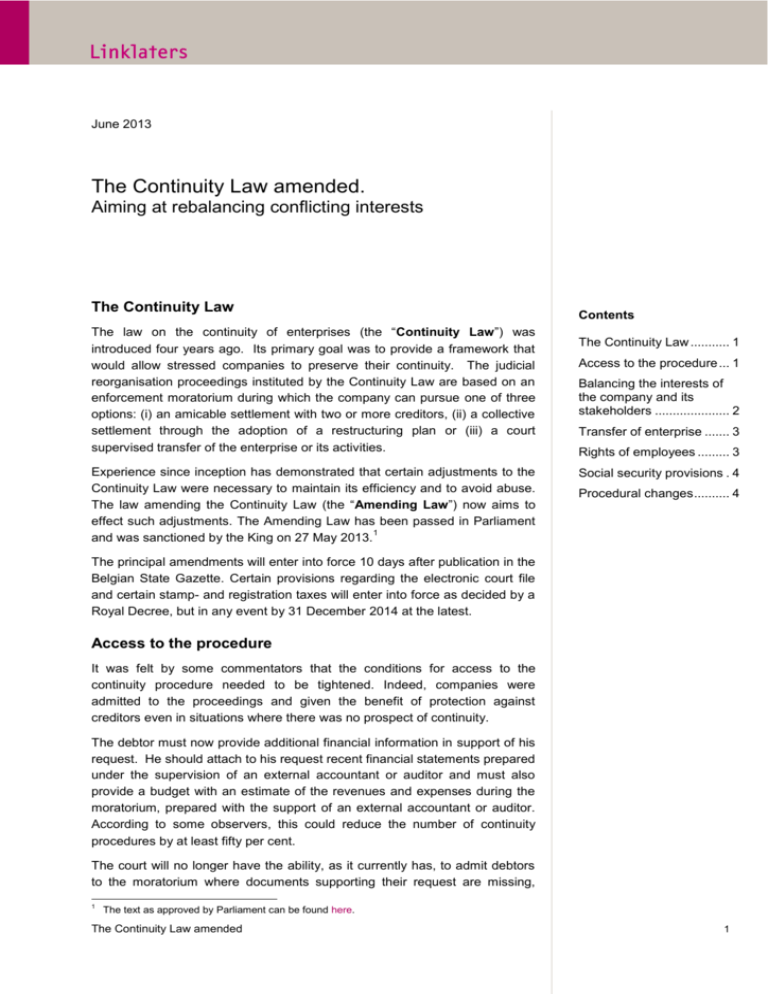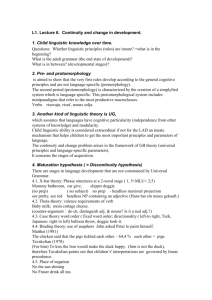
June 2013
The Continuity Law amended.
Aiming at rebalancing conflicting interests
The Continuity Law
The law on the continuity of enterprises (the “Continuity Law”) was
introduced four years ago. Its primary goal was to provide a framework that
would allow stressed companies to preserve their continuity. The judicial
reorganisation proceedings instituted by the Continuity Law are based on an
enforcement moratorium during which the company can pursue one of three
options: (i) an amicable settlement with two or more creditors, (ii) a collective
settlement through the adoption of a restructuring plan or (iii) a court
supervised transfer of the enterprise or its activities.
Experience since inception has demonstrated that certain adjustments to the
Continuity Law were necessary to maintain its efficiency and to avoid abuse.
The law amending the Continuity Law (the “Amending Law”) now aims to
effect such adjustments. The Amending Law has been passed in Parliament
1
and was sanctioned by the King on 27 May 2013.
Contents
The Continuity Law ........... 1
Access to the procedure ... 1
Balancing the interests of
the company and its
stakeholders ..................... 2
Transfer of enterprise ....... 3
Rights of employees ......... 3
Social security provisions . 4
Procedural changes .......... 4
The principal amendments will enter into force 10 days after publication in the
Belgian State Gazette. Certain provisions regarding the electronic court file
and certain stamp- and registration taxes will enter into force as decided by a
Royal Decree, but in any event by 31 December 2014 at the latest.
Access to the procedure
It was felt by some commentators that the conditions for access to the
continuity procedure needed to be tightened. Indeed, companies were
admitted to the proceedings and given the benefit of protection against
creditors even in situations where there was no prospect of continuity.
The debtor must now provide additional financial information in support of his
request. He should attach to his request recent financial statements prepared
under the supervision of an external accountant or auditor and must also
provide a budget with an estimate of the revenues and expenses during the
moratorium, prepared with the support of an external accountant or auditor.
According to some observers, this could reduce the number of continuity
procedures by at least fifty per cent.
The court will no longer have the ability, as it currently has, to admit debtors
to the moratorium where documents supporting their request are missing,
1
The text as approved by Parliament can be found here.
The Continuity Law amended
1
except in the context of a transfer of enterprise ordered at the request of the
public prosecutor or a third party.
A mechanism has also been introduced to ensure that companies that went
through a judicial reorganisation procedure cannot use a subsequent
procedure to affect the rights of creditors as set during the initial procedure.
Balancing the interests of the company and its stakeholders
One of the main goals of the Amending Law is to strike a better balance
between the interests of all stakeholders of the company facing difficulties as
well as to address uncertainties resulting from the original text of the law.
>
The nature of a creditor’s claim, i.e. whether it is ordinary or
extraordinary, will be fixed at the time of the opening of the
proceedings. Creditors will then no longer be able to “upgrade” their
claim during the proceeding by taking security (e.g., the tax authorities
taking a legal mortgage).
>
The moratorium does not extend to pledges over receivables, but only
to the extent that the receivables were specifically pledged at the time
that the pledge was created.
>
The debtor will only be able to make voluntary payments of debts
caught by the moratorium if such payments are necessary for the
continuity of the enterprise. This addition of a condition regarding the
necessity of the payment may well be counterproductive as the
criterion is rather hard to establish.
>
For agreements with successive performance (for which the Continuity
Law provides that they are not subject to the moratorium if they
concern performances after the opening of the continuity procedure),
the payment of the contractual interest is also exempt from the
moratorium.
>
The Amending Law attempts to mitigate some of the excesses in the
differential treatment of various claims of creditors in the reorganisation
plan. Any creditor will now be entitled to at least 15% of his claim.
Second, public creditors benefiting from a general lien (e.g., tax
authorities and the social security administration) should enjoy at least
the same benefits as the best treated common creditors in the
moratorium (i.e. those creditors not benefiting from a security interest).
Deviations from these principles are possible in exceptional
circumstances to the extent that they are justified with a view to the
continuity of the enterprise. A separate point is that the reorganisation
plan can not provide for the reduction or release of debts related to
employment, alimony, physical damage and criminal fines.
>
An important clarification with respect to the legal position of the
creditor is that a creditor will be explicitly allowed to suspend its
performance of an agreement to the extent that the debtor previously
used its right not to execute the same agreement (when such is
The Continuity Law amended
2
necessary for the reorganisation plan or a transfer to third parties). This
follows from the general law of obligations (exceptio non adimpleti
contractus).
>
The role of the court in assessing the plan has been the subject of
debate and considerable case law, including from the Supreme Court.
The preparatory works of the Amending Law now state that the court
should only marginally assess whether the proposal of the debtor is in
line with the economic public order, equal treatment of creditors and
commercial competition and whether the legal formalities are
respected. According to the legislation, such is not the case if creditors
are manifestly unequally treated without there being a link to the
continuity of the business, in case of false reasoning of the content of
the reorganisation plan or the concealment of other creditors. If any
such issue arises, the court can grant the debtor the opportunity to
submit a new draft reorganisation plan.
Transfer of enterprise
The judicial reorganisation through the transfer of enterprise has been
criticised quite substantially, in particular because of the absence of precise
rules surrounding the process.
The Amending Law brings clarification to the Continuity Law with respect to
the selection of the purchaser of the business. A new element is that the
purchaser of the business should clearly mention the guarantees that it can
offer with respect to the preservation of employment and the payment of the
purchase price. Importantly, it is clearly stated in the Continuity Law that the
price of the transferred assets should at least be the liquidation value. The
legislator continues to attach great importance to the preservation of
employment: in case of comparable offers, priority will be given to the offer
guaranteeing employment by way of social agreement.
Rights of employees
On 5 October 2011, the social partners in the National Labour Council
concluded Collective Bargaining Agreement No. 102 (the “CBA”) based on
Article 61 of the Continuity Law. The Amending Law now aims to ensure a
better consistency between the Continuity Law, containing the general legal
framework, and the CBA which includes more specific provisions applicable
in the case of a transfer of enterprise. Those rules provide for protective
measures such as information duties to employees and/or the transferee,
preservation of the rights and obligations of the transferred employees and
rules regarding the selection of employees (which is still made by the
transferee).
The Amending Law also amends the Law regarding the Organisation of the
Economy, which regulates the impact of a transfer of enterprise on employee
representatives. Employee representatives who are transferred within
continuity proceedings must still be able to exercise their mandate with their
new employer. Their dismissal protection is also preserved.
The Continuity Law amended
3
Contacts
Social security provisions
The Amending Law abolishes, in line with legal scholars’ views, the obligation
of the principal to pay 35 per cent of the invoices of the contractor with social
security debts in a judicial reorganisation procedure directly to the Social
Security Administration (RSZ/ONSS) on the day of payment. The amendment
appeared justified as this provision often made it difficult for the debtor to
finance his activities.
Procedural changes
The Amending Law also provides a number of procedural changes.
First, the Continuity Law allowed a creditor to dispute the amount or the
category allocated to his claim by the debtor in the reorganisation plan. The
Amending Law, however, limits this possibility in time: a creditor needs to
bring such a dispute before the court at least 14 days before the
reorganisation plan is submitted to vote. If the creditor fails to do so he will
only be able to vote in accordance with the amount allocated to his claim in
the plan put to the vote. Accordingly, creditors would be well advised in future
to follow the status of the procedure more closely.
For further information
please contact:
Charles-Antoine Leunen
Partner
(+32) 2 501 9120
charlesantoine.leunen@linklaters.com
Stefaan Loosveld
Partner
(+32) 2 501 9521
stefaan.loosveld@linklaters.com
David Ballegeer
Partner
(+32) 2 501 9593
david.ballegeer@linklaters.com
Second, under the current Continuity Law the debtor, the public prosecutor or
any interested party could already request the court to prematurely end the
judicial reorganisation procedure if it has become clear that the debtor is no
longer able to ensure the continuity of (part of) the company. The Amending
Law now expressly provides that the delegated judge will bring such a
situation ex officio to the attention to the court. The court will then decide
whether or not to end the continuity procedure after having heard both the
debtor and the public prosecutor. Creditors therefore should make sure that
they are aware of the delegated judge’s views in this respect so that they can
correctly assess the situation and take appropriate measures.
Third, the Amending Law provides that an intervention in a continuity
procedure will only be possible through a formal request to intervene. In
future only third parties who have filed such a request will be considered to be
a party to the proceedings and will be able to appeal certain decisions in the
framework of the continuity procedure.
Authors: Charles-Antoine Leunen and Els Janssens
If you would prefer to receive this e-mail in plain text, please let us know by e-mailing marketing.belgium@linklaters.com.
This e-mail is intended merely to highlight issues and not to be comprehensive, nor to provide legal advice. Should you
have any questions on issues reported here, please contact your regular contact at Linklaters. We hold your e-mail
address, which we use to send you this news update and other marketing and business communications. We use your
details for our own internal purposes only. This information is accessible by our offices worldwide and our associated firms.
If any of your details are incorrect or if you no longer wish to receive e-mails (please specify which emails) from us, please
let us know by e-mailing us at marketing.belgium@linklaters.com © Linklaters LLP. All Rights reserved 2013
Rue Brederode 13
B - 1000 Brussels
Telephone (+32) 2 501 94 11
Facsimile (+32) 2 501 94 94
Linklaters.com
The Continuity Law amended
4









